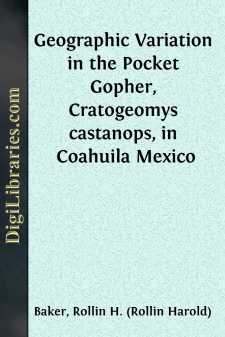Categories
- Antiques & Collectibles 13
- Architecture 36
- Art 48
- Bibles 22
- Biography & Autobiography 813
- Body, Mind & Spirit 142
- Business & Economics 28
- Children's Books 17
- Children's Fiction 14
- Computers 4
- Cooking 94
- Crafts & Hobbies 4
- Drama 346
- Education 46
- Family & Relationships 57
- Fiction 11829
- Games 19
- Gardening 17
- Health & Fitness 34
- History 1377
- House & Home 1
- Humor 147
- Juvenile Fiction 1873
- Juvenile Nonfiction 202
- Language Arts & Disciplines 88
- Law 16
- Literary Collections 686
- Literary Criticism 179
- Mathematics 13
- Medical 41
- Music 40
- Nature 179
- Non-Classifiable 1768
- Performing Arts 7
- Periodicals 1453
- Philosophy 64
- Photography 2
- Poetry 896
- Political Science 203
- Psychology 42
- Reference 154
- Religion 513
- Science 126
- Self-Help 84
- Social Science 81
- Sports & Recreation 34
- Study Aids 3
- Technology & Engineering 59
- Transportation 23
- Travel 463
- True Crime 29
A New Long-eared Myotis (Myotis Evotis) From Northeastern Mexico
Description:
Excerpt
Long-eared bats obtained by field parties from the University of Kansas in the Mexican states of Coahuila, Nuevo León, and Tamaulipas, are found to belong to the species, Myotis evotis, but are not referable to any named subspecies. They are named and described as follows:
Myotis evotis auriculus new subspecies
Type.—Female, adult, skin and skull; No. 55110, Univ. Kansas Mus. Nat. Hist.; 10 mi. W and 2 mi. S Piedra, 1200 ft., Sierra de Tamaulipas, Tamaulipas; 9 June 1953; obtained by Gerd H. Heinrich, original number 7061.
Distribution.—Coastal foothills and adjacent mountains of northeastern México from central Coahuila south and east to central Veracruz.
Diagnosis.—Size medium (see measurements), ears small for the species; color dark, upper parts (j14) Ochraceous-Tawny (color terms are after Ridgway, Color Standards and Color Nomenclature, Washington, D. C., 1912), underparts Warm Buff, ears pale; skull large, teeth large, mandible long.
Comparison.—From Myotis evotis evotis (H. Allen), from Colorado, Wyoming, and Montana, M. e. auriculus differs in: Ears averaging shorter; color darker and richer; ears paler and contrasting less, in color, with pelage; skull larger in all measurements taken except that of least interorbital constriction; forehead, when viewed laterally, rising more abruptly, because frontal region is more inflated; teeth larger.
Remarks.—Myotis evotis auriculus, although no larger externally than M. e. evotis, has a larger skull, which in lateral view has a more abruptly rising forehead. The teeth, especially the first upper premolars, of auriculus are noticeably larger than those of evotis. The first two lower premolars are sub-equal in auriculus whereas in evotis the first lower premolar usually is larger. The mandible, in relation to the greatest length of the skull, is longer in auriculus (ratio, 71-74) than in evotis (ratio, 67-71).
Coahuilan specimens, although assigned to auriculus, are slightly paler (upper parts (16) Ochraceous-Tawny; underparts (e) Light Buff) and have less abruptly rising foreheads than do the bats from Tamaulipas. In these features, the Coahuilan animals are somewhat intermediate between typical auriculus and evotis. The bat from Nuevo León, in both color and degree of slope of forehead, is intermediate between those from Coahuila and those from Tamaulipas.
A bat from Perote, Veracruz, identified as Myotis evotis chrysonotus (J. A. Allen) [=M. e. evotis] by Miller and Allen (U. S. Nat. Mus., Bull. 144:118 and 120-121, May 25, 1928) is here assigned to M. e. auriculus. Measurements given by these authors indicate that this bat has a large skull, which is characteristic of this subspecies. Another specimen, similarly assigned by these authors and from the San Luis Mountains in northwestern Chihuahua, seems to be M. e. evotis, although the published measurements (loc. cit.) show that this bat tends toward auriculus in size of skull and mandible.
All specimens were taken in mist nets stretched over water. Those from Coahuila were snared over a concrete water tank situated near the base of low hills in mixed mesquite and chaparral. In Nuevo León, one bat was netted over a small pond around which grew some low trees in an intermontane valley in the Sierra Madre Oriental....









